Strongman in Circuses
The image of the circus strongman, effortlessly bending iron bars and lifting colossal weights, is not merely a relic of a bygone entertainment era but a symbol that continues to captivate and inspire within the modern circus. For many, the strongman is the quintessence of the circus itself—a showcase of both raw power and dramatic flair. This article explores the evolution, historical significance, and continued relevance of the strongman in today’s circus performances.
Historical Beginnings
The allure of the strongman can be traced back to ancient civilizations, where feats of strength were a common form of entertainment at festivals and royal courts. However, it wasn’t until the 19th century that the strongman became a staple in the burgeoning modern circus. Icons like Eugen Sandow not only demonstrated their incredible strength but also transformed their bodies into living sculptures, representing the apex of physical perfection and human potential.
The Evolution of the Strongman Act
Originally, the strongman act was a straightforward demonstration of brute strength, often involving the lifting of heavy weights and the bending of hard metals. As the circus arts evolved, so too did the nature of the strongman act. Today, it incorporates elements of dance, acrobatics, and even narrative storytelling. Modern strongmen and strongwomen blend their impressive physical feats with emotional depth, turning the act into a rich performance that transcends a simple show of force.
Strongmen performed various demonstrations of raw strength in circuses that often included:
- Lifting heavy weights, such as large dumbbells, barbells, or awkward objects like anvils and large rocks.
- Bending steel bars or rods, sometimes using only their hands or even their teeth.
- Breaking chains or shackles, either by pulling them apart or expanding their chest muscles.
The strongman act was about more than just displaying brute strength; it was a highly theatrical and often interactive part of the circus, designed to amaze, entertain, and sometimes even involve the audience in the wonder of human physical capabilities
Famous Circus Strongmen
Eugen Sandow (1867–1925)
Sandow was renowned for his ability to perform incredible feats of strength, such as bending iron bars, lifting heavy weights, and performing what was known as the “Tomb of Hercules,” where he supported enormous weights on a platform held aloft on his chest. His performances were not just demonstrations of power; they were carefully choreographed to display his physique, making him one of the early proponents of bodybuilding as a form of art.
Sandow also made significant contributions to the world of physical fitness. He wrote several books and articles about exercise and health and even developed his own line of exercise equipment. His influence was so profound that he is often referred to as the “Father of Modern Bodybuilding.” Sandow organized the first-ever bodybuilding contest at the Royal Albert Hall in London in 1901, which further solidified his importance in the history of physical culture.
Louis Cyr (1863–1912)
Born Cyprien-Noé Cyr in Saint-Cyprien-de-Napierville, Quebec, Canada, Louis Cyr‘s reputation as a strongman began in his early years and grew as he performed in various venues, including circuses and vaudeville stages across North America and Europe. His size and strength caught the attention of many, and he quickly became a celebrated figure.
Louis Cyr’s strength acts included lifting enormous weights, such as carrying a platform on his back holding multiple people or heavy objects. One of his most famous feats was lifting a 500-pound weight with one finger and supporting a platform loaded with 18 men, weighing about 4,337 pounds. Another legendary act involved resisting the pull of four horses—two on each arm.
Zishe Breitbart (1883–1925)
Zishe Breitbart was born in Poland and began his career in Europe before taking his acts to the United States. He was a Jewish strongman, which added a cultural and ethnic dimension to his appeal, especially among Jewish communities during a time of widespread anti-Semitism.
Breitbart was famous for his incredible feats, such as bending iron bars, snapping chains, and lifting heavy weights. One of his signature acts involved driving nails through metal plates with his bare hands. He also performed the classic strongman act of supporting heavy weights with his body while lying on a bed of nails.
Breitbart toured extensively, performing in circuses and vaudeville theaters across Europe and America. His acts were a mixture of traditional strongman stunts and dramatic presentations that highlighted his impressive physique and strength. He often portrayed biblical heroes like Samson in his performances, drawing on his Jewish heritage to resonate with his audience.
Final Thoughts
The circus strongman, with its deep historical roots and dynamic presence in contemporary performances, continues to be a vital part of the circus arts. As circuses around the world innovate and transform, the strongman stands as a testament to the art form’s rich heritage and its limitless potential for creativity and spectacle. From the muscle-bound icons of yesteryears to today’s versatile performers, the strongman act remains a powerful symbol of what humans can achieve with determination and a dash of theatrical flair. This journey through the evolution of the circus strongman illustrates why this act has been, and continues to be, a beloved feature of the circus world.



